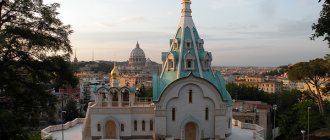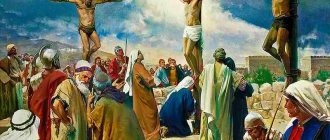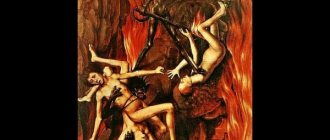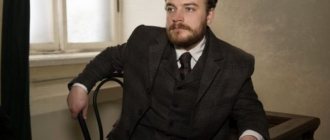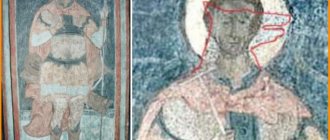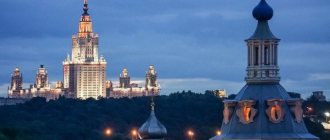Vladimir Legoyda
Table of contents
- I'm making up hypotheses!
- Are God and the Universe “twin brothers”?
- Why were the inquisitors afraid of the verdict?
Despite the fact that the idea of religion as “the opium of the people” is no longer modern and relevant, many old views do not change and continue to wander from generation to generation. One of these ideas is the struggle between religion and science “not to the death, but to the death.” Supporters of this view habitually trump famous names: Copernicus, Galileo, Bruno. The most amazing thing is that the myths about these “martyrs of science” have become so firmly entrenched in everyday consciousness that sometimes it seems that they cannot be eradicated. Times change, history is subject to close and scrupulous analysis, but defenders of scientists allegedly offended by Christianity continue to accuse the “damned churchmen” of destroying science. The reason for the persistence of these myths is a topic for a separate serious conversation, involving both historians and cultural experts, as well as psychologists and sociologists. The purpose of our publications is somewhat different - to try to understand, firstly, what actually happened and, secondly, how much what happened relates to the conflict between religion and science, if such is possible at all. We talked about Galileo in the second issue of our magazine for this year. Today we will talk about Giordano Bruno.
I'll start by stating a fact: Giordano Bruno (1548–1600) actually suffered at the hands of the inquisitors. On February 17, 1600, the thinker was burned in the Piazza des Flowers in Rome. Regardless of any interpretations and interpretations of events, the fact always remains: the Inquisition sentenced Bruno to death and carried out the sentence. Such a step can hardly be justified from the point of view of evangelical morality. Therefore, Bruno's death will forever remain a regrettable event in the history of the Catholic West. The question is different. Why did Giordano Bruno suffer? The existing stereotype of a science martyr does not even allow one to think about the answer. How for what? Naturally, for your scientific views! However, in reality this answer turns out to be at least superficial. But in fact, it is simply incorrect.
Biography and biography
Giordano Bruno was born in the city of Nola in 1548, which was located near Naples. When the future great philosopher was just born, he was named Filippo. In those years, a large number of people combined their names with their place of birth, so after some time Giordano began to be called Bruno Nolanz.
Bruno's family consisted of his father, who was at that time a hired soldier, and his peasant mother.
Childhood and youth
When Giordano was 11 years old, his family sent him to Naples to study sciences such as literature, logic and dialectics. The boy graduated from his first school successfully, and after it he went for further studies to the monastery of St. Dominic (Monastero di San Domenico) - this happened when he had barely reached his fifteenth birthday. Due to his overly sociable, impudent and irrepressible character, Giordano often got into verbal altercations with his elders, which provoked numerous conflicts on various topics.
In 1565, Filippo was tonsured a monk, after which he received the church name Giordano. He spent about ten years in Naples, after which he fully became a Catholic monk, and even managed to finish his first work in 1568, entitled “Noah’s Ark” (arca di Noè). He decided to dedicate this work to Pope Pius V (Pius PP. V).
At the age of 24, Giordano Bruno held his first church service. He spent his free hours in the local library, which was located at the monastery, studying the works of such philosophers as Aristotle and Ptolemy.
According to the Index of Forbidden Books, which was published in 1559, these and some other philosophers were in the section of literature of dubious content, so priest Giordano often caught the sidelong glances of other monks, and especially abbots.
Many of his brothers were alarmed by the fact that Giordano took icons out of his cell and left only the crucifix. For this reason, after some time, the young man decided to leave the monastery, since the monks began to tell him almost directly about their suspicions.
A few years later he receives the title of scientist, which gives the future philosopher the right to lecture.
Wandering period
In order not to incur persecution and the resulting troubles, Giordano first went to Rome, and after some time he decided to move even further, to the north of Italy. But even there the philosopher did not stay long. Bruno leaves the country in the late 70s of the 16th century and goes to Switzerland.
Next, the philosopher made London his place of residence, but after a few years he decided to move to Oxford. However, Giordano had a slight conflict with local teachers, and this situation forced him to come to the capital of Great Britain again.
During the same period, in 1584, he published one of the largest and most famous works entitled “On the infinity of the universe and worlds” (“sull’infinito dell’universo e dei mondi”).
In subsequent years, despite the fact that Giordano enjoyed the support of the English authorities, he was again forced to leave his home. The philosopher moved to France because he was also a revered figure here; in particular, he enjoyed the patronage of the French envoy Michel de Chateauneuf de la Movisière.
However, the philosopher did not stay long in France. Almost immediately after his arrival in this country, he moved to Germany. From there he goes to Marburg, but even here he is still prohibited from giving lectures. Giordano Bruno at that time understood that the clouds were gradually beginning to thicken over him, since almost every third person around him suspected him of heresy.
In 1586-1588 he was in Wittenberg, which in those days was called the cradle of Protestantism. In this city, Giordano received the right to give his lectures, but after a short period of time he also had to leave it. When he was about to leave Wittenberg, he delivered his eulogy, which was dedicated to Luther.
Luther's views were close to Giordano, he constantly admired the oratorical abilities of this young man, believing that he received them from another no less famous figure of those times - Girolamo Savonarola.
Giordano moved from city to city in subsequent years. He lived in Prague, Helmstedt and Zurich and Frankfurt am Main. Only at the end of the century did he manage to return to his homeland.
Royal friend
For the Vatican, the verdict of Giordano Bruno was not just a condemnation of a Dominican monk who had fallen into heresy. At the end of the 16th century, in terms of popularity among European intellectuals, Bruno could have given odds to modern cosmologist Stephen Hawking. Giordano Bruno maintained very friendly relations with the kings of France Henry III and Henry IV, the British Queen Elizabeth I, the Holy Roman Emperor Rudolf II and many other European “rulers”. With a snap of his fingers, he could receive a chair and a professor's robe at any European university, his books were published in the best printing houses, and the best minds of the continent dreamed of his patronage.
Giordano Bruno's main calling card was not cosmology, but his excellent memory. Bruno developed mnemonics (the art of memory), which was then at the height of fashion among intellectuals. They say that Giordano memorized thousands of books, ranging from the Holy Scriptures to Arabic alchemical treatises. It was the art of memorization that he taught to Henry III, who was proud of his friendship with the humble Dominican monk, and to Elizabeth I, who allowed Giordano to enter her chambers at any time, without reporting. In addition, the monarchs enjoyed how Bruno, with mocking grace, “knocked out” teams of Sorbonne and Oxford professors with his intellect on any issue.
For Giordano Bruno, intellectual combat was a kind of sport. For example, Oxford academics recalled that he could easily prove that black is white, that day is night, and the Moon is the Sun. His debating style was similar to boxer Roy Jones in the ring at his best - a comparison that boxing fans will understand well. It must be admitted that it was hardly thanks to Bruno’s supernatural memory alone that he found himself on friendly terms with the most influential monarchs of Europe.
As biographers recall, some invisible force moved this Dominican monk through the life, easily brought him to the best palaces of Europe, protected him from the persecution of the Inquisition (for Bruno often mentioned theology in his statements). However, unexpectedly this force failed in May 1592.
Scientific activity and teaching
Throughout his travels, Giordano Bruno has been tirelessly looking for a teaching job, but he has never been in one place for a long time. There were several reasons for this situation: firstly, the philosopher, with his slightly different views from generally accepted positions, attracted the attention of the authorities, and secondly, he gave other priests and teachers a reason to write denunciations.
However, Giordano was not one of those people who like to keep his mouth shut; he was never afraid to express his views.
As you know, such an approach to the world around us does not end well, so Giordano was famous for his amazing talent with the help of a couple of phrases to make enemies for himself. For example, he liked to introduce himself to professors at Oxford University in this way: “I, Philoteus (which meant “friend of God”), professor of pure and harmless wisdom, am hated only by fools, but respected and honored by scholars who know what honesty is.”
The teaching chronology of Giordano Bruno is as follows:
- 1579 Giordano moves to Geneva , where he gets the opportunity to teach and lecture. However, soon other professors begin to suspect him of heresy, so the philosopher moves to France. During his stay in Geneva, he managed to make many enemies among the Calvinists.
- 1581 Giordano becomes a teacher at the Sorbonne University. Thanks to his persistence and charm, he gains the favor of the reigning monarch, Henry III of France. The king, like his mother, Catherine Maria Romola di Lorenzo de Medici, was fond of magic, so he liked the somewhat eccentric and restless character of the teacher from Italy. For this reason, Henry contributed to the improvement of Giordano in his country. However, the philosopher did not have to stay in France for long, since with his overly open activities he again fell under suspicion.
- 1583 Giordano moved to England, starting to teach first in London and then in Oxford. He publishes several of his works: “The Feast on the Ashes” (“Festa sulle ceneri”) and “The Expulsion of the Triumphant Beast” (“Esilio della bestia trionfante”). Numerous conflicts and disputes with other professors force him to leave Oxford and return to the capital. There Giordano decides to make an attempt to convince people close to the court that Copernicus’s views were in many ways not far from the truth, but his efforts ultimately proved futile. At court, his position was supported only by the court physician of James I. But even he does not openly express his disposition. For this reason, Giordano had to wander the world again.
- 1585 The philosopher moves to France , where he makes attempts to resume his teaching activities, but Giordano expected another failure. When he felt that suspicions against him were beginning to intensify, he decided that for his own safety it was worth leaving this country.
- 1586 Giordano moves to German territory. Tired of endless wanderings, the philosopher hopes that luck will smile on him here and he will be able to find a job. However, practically no university accepts Giordano. Only the small town of Marburg was favorable to him, where the philosopher was given a teaching position.
- 1586-1588. The city of Wittenburg becomes Giordano's refuge. This time can be called relatively calm, since during it the philosopher does not arouse virtually any suspicion about himself. However, Giordano’s character and disposition could not allow him to remain silent about his own views on the world, which were very different from the views of the church, so the philosopher hastily moved to Prague.
- 1591 After further wanderings around the world, Giordano stops in Frankfurt, where he publishes several of his serious works. For them he receives his first substantial fee, but there is no way for him to stay in this city after such a large-scale breakthrough. Therefore, the wandering monk decides to go back to his homeland.
Throughout his travels, Giordano showed traits that were alien to many of his contemporaries. For example, he did not accept traditions that his mind could not come to terms with. The philosopher was too straightforward, so he was never shy about speaking out about other professors. At Oxford, Giordano from time to time allowed himself to call his colleagues fools and imbeciles.
Bruno was called a citizen of the world, the son of the Earth and the Sun, and also an academician without an academy.
Discoveries
Giordano Bruno did not make any discoveries as such. This philosopher became famous for promoting the teachings of Copernicus, and also based on it he created his own idea of our planet and the Universe as a whole.
The philosopher also became famous in his time for repeatedly ridiculing figures of the Catholic Church and making fun of the Pope. During Giordano’s life, the Pope was considered (as he is now) the vicar of God on Earth, and this a priori implied that everything he had done was correct.
However, the famous philosopher was convinced that if he were asked the question whether the Pope could be wrong, he would answer: “Of course, the Pope can be wrong! Both the common man in general and the bad man in particular.”
Basics of teaching
Giordano Bruno's versatile teaching touched on both science and faith. When the thinker returned to Italy, he already saw himself as a preacher of a reformed religion. It should have been based on scientific knowledge. This combination explains the presence in Bruno’s works of both logical reasoning and references to mysticism.
Of course, the philosopher did not formulate his theories in a vacuum. The ideas of Giordano Bruno were largely based on the works of his numerous predecessors, including those who lived in ancient times. An important foundation for the Dominican was radical Neoplatonism. This ancient philosophical school taught a mystical-intuitive way of understanding the world, logic, etc. The thinker adopted from it ideas about the world soul that moves the entire Universe, and the single beginning of existence.
Bruno also relied on Pythagoreanism. This philosophical and religious teaching was based on the idea of the universe as a harmonious system, subject to numerical laws. His followers significantly influenced Kabbalism and other mystical traditions.
Worldviews
Giordano Bruno is a man who at one time united religion and science, even if it happened within himself, and not in the outside world. In almost every work of his, this philosopher was not afraid to directly call stupidity stupidity, since he saw the absurdity present in the views of the church. He did not want to accept those dogmas that were located on the pages of ancient books, because he saw values in other areas. For him, the basis of all foundations were freedom, love, as well as the desire of each person for his own personal happiness.
Giordano saw the abnormality in the fact that leaving the Catholic Church at the time he lived was severely punished, and entry into it was through baptism, and infants were not even asked whether they wanted it or not.
In the event that a person conceals something from the holy father during confession or at various kinds of meetings in the church, then this was a serious reason for subjecting the person to punishment. Even if a person missed one or more church services, he could already incur the wrath of the Holy Inquisition.
It was unbearable for Giordano to see what the Holy Inquisition was doing to people. Moreover, it is not at all necessary that a person could end his life at the stake. The philosopher saw the worst fate as a broken life, by which Giordano Bruno understood the renunciation of his own beliefs, as well as persecution from the people around him for disobedience to the Catholic Church. It was for this reason, since the philosopher saw the events taking place from the inside, that he decided to escape from his native country to one that was beyond the control of the Pope and the Vatican (Stato della Città del Vaticano), to Switzerland.
At the same time, Giordano Bruno developed his own cosmological concept, based on the basic statements of Copernicus. Moreover, his system was practically indistinguishable from the modern one. Giordano saw our Universe without edge and end, and it did not consist, as the Catholic Church believed, only of the Earth and the Sun revolving around it.
The great philosopher was convinced that vast space is filled with countless stars, around which planets similar to Earth revolve. Between themselves, these bodies can differ in radiation brightness and size. Giordano assumed that somewhere far away there are stars that are much larger in size than our Sun. However, the planets do not have such radiation that they can be seen from Earth with the naked eye.
A distinctive feature of Giordano from the ideas of Copernicus is that he rejected the celestial spheres, that is, the philosopher refused to believe that there are transparent or invisible surfaces on which all the planets and stars are located. Giordano could not name a specific reason why these bodies were weightless, but he was firmly convinced that no invisible platform existed under the celestial bodies. Such spheres were part of the ideas about the world of Aristotle, Ptolemy, Copernicus, they were even recognized by the Bible itself. According to Giordano Bruno, such a worldview greatly hampered the development of science in past times.
The philosopher was also sure that there were other worlds outside our planet where intelligent life was present. Along with this, Giordano conducted numerous studies that had a magical basis. The philosopher settled on only nine magical forms.
When he wondered what the soul was, Giordano decided to devote another study to this. It is not entirely clear how exactly through experiments he wanted to answer this question, but in the process of his own actions he came to the conclusion that the soul is a metaphysical body that is endowed with the ability to be transmitted from one “vessel” to another. As researchers suggest, with this Giordano makes a reference to the fact that a person is able to reincarnate after death.
What about the age-old historical conflict between science and religion?
Everything is very simple here - there was no “centuries-old conflict”. The myth of the conflict arises only towards the end of the 19th century, and we even know its authors - this is John William Draper, who published a book in the USA in 1874 called “The History of the Struggle between Science and Religion.” Another author, Andrew Dickson White, wrote anti-religious articles around the same time, and in 1896 published the book “History of the War between Science and Theology in Christendom.” In our time, historians of science do not support the model of conflict that Draper and White build on two episodes relating to Galileo and Darwin, and prefer the so-called “complex” model, since religious leaders took very different positions in relation to science.
Renowned biologist and personal agnostic Stephen Jay Gould says: “Draper's and White's narratives are in stark contrast to what actually happened in the relationship between science and religion... Both use myths to support their visions of history—such for example, like the “flat earth” myth.
Other achievements
Almost no one currently knows that in addition to the fact that Giordano Bruno was a scientist, he was also a talented poet. The philosopher wrote poems on a variety of topics, but devoted a lot of space in his work to satire. This is quite natural, because given how much his ideas about the world differed from generally accepted visions, he could not help but consider those around him foolish.
It was Giordano who created a dramatic style that was based on the free expression of thoughts. In his poems, he very vividly and realistically reflects the morals of the era in which he happened to live. The philosopher ridicules hypocrisy, pedantry, superstition and childish naivety on the pages of his works. He saw all these qualities in his contemporaries. If you read the meaning of the messages between the lines, you will notice that despite the fact that the philosopher makes fun of these traits of people, he is sincerely sad that the Catholic Church does not allow the “servants of God” to become better.
Who burned at the stake?
The only written evidence of the execution of Giordano Bruno has reached us. The witness was a certain Kaspar Schoppe, a “repentant Lutheran” who went into the service of the cardinal. Schoppe wrote in a letter to his comrade that the “heretic” accepted death calmly: “Without repenting of his sins, Bruno went to the worlds he imagined to tell what the Romans were doing with blasphemers.” I wonder why Schoppe thought that Giordano Bruno’s heresy lay in his view of the Universe - nothing was said about this in the verdict?
Schoppe, by the way, pointed out in his letter to a friend one interesting detail - Giordano Bruno was taken to the stake with a gag in his mouth, which was not in the tradition of the Inquisitorial burnings. It is unlikely that the organizers of the execution were afraid of the possible dying curses of the condemned man - this, as a rule, was the format of any execution. As well as repentance. Why the gag? It is unlikely that in a matter of minutes of execution, even such an intellectual and polemicist as Bruno would have been able to convince the illiterate crowd of the infidelity of Aristotelian cosmology. Or the executioners were simply afraid that the condemned man, in a moment of absolute despair, would suddenly shout out the terrible: “I am not Giordano Bruno!”
Related posts:
Comment
Personal life
There is no information about what happened in the philosopher’s personal life. The only information known is that Giordano did not have a wife or children, as well as students or any followers. Some researchers even suggest that the great philosopher had homosexual tendencies. It is worth noting that homosexuality was not uncommon in the Middle Ages, and it was widespread among monks and priests.
In portraits, Giordano looks like a very fragile and constantly thoughtful young man.
Therefore, many biographers have repeatedly said that the philosopher’s passion for magic and science was so great that it replaced his carnal pleasures with a woman.
Hermeticism
Another significant source of inspiration for Bruno was Hermetic philosophy. This teaching appeared in the era of late Antiquity, when Hellenism was experiencing its heyday in the Mediterranean. The basis of the concept was ancient texts, according to legend, given by Hermes Trismegistus.
The teaching included elements of astrology, magic and alchemy. The esoteric and mysterious character of the Hermetic philosophy greatly impressed Giordano Bruno. The era of antiquity was long in the past, but it was during the Renaissance that a fashion for studying and rethinking such ancient sources appeared in Europe. It is significant that one of the researchers of Bruno’s heritage, Francis Yates, called him a “Renaissance magician.”
Trial and death
In 1591, Giordano Bruno was invited to visit him in Venice by a young man of aristocratic origin named Giovanni Mocenigo under the pretext of teaching mnemonics. In the process of learning, Giovanni asked Giordano about his worldviews and scientific activities. It would seem that a warm friendship began between them, but already on May 23, 1592, the aristocrat sent his first denunciation against the philosopher to the inquisitor.
This denunciation stated that Giordano Bruno was spreading heretical views, rejecting in every possible way the dogmas of the Catholic Church, and also argued that the Church’s ideas about the world order were fundamentally wrong. Several more similar denunciations were sent on May 25 and 26 of the same year.
After this, the Holy Inquisition demanded that Venice hand over Giordano to her in order to put him on trial. On February 27, 1593, the philosopher was taken to Rome and imprisoned in the Castel Sant'Angelo. No matter how the philosopher is tortured, he does not admit his heresy and does not reject his own views. Giordano is firmly convinced that all his beliefs are correct, but the Catholic Church, on the contrary, forces people to believe in lies.
The following year, on February 9, the tribunal of the Holy Inquisition finds Giordano Bruno guilty on eight counts. After this, he was excommunicated from the church and deprived of his priesthood. Once all the necessary preparations were completed, Giordano was sentenced to punishment "without shedding of blood." In those days, this meant burning at the stake. The great philosopher was executed on February 17 in Rome on Campo dei Fiori.
The last words of Giordano Bruno were: “To burn does not mean to refute!”
The Art of Memory as a Fatal Mistake
But Bruno made a mistake that cost him his life: he went to teach the art of memory to the Venetian aristocrat Giovanni Mocenigo, who in 1592 wrote a complaint against him to the local Inquisition:
“I, Giovanni Mocenigo, convey out of the duty of conscience and by order of my confessor that I heard many times from Giordano Bruno when I talked with him in my house that the world is eternal and there are infinite worlds ... that Christ performed imaginary miracles and was a magician, that Christ he did not die of his own free will and tried as much as he could to avoid death; that there is no retribution for sins; that souls created by nature pass from one living being to another. He talked about his intention to become the founder of a new sect called “New Philosophy”. He said that the Virgin Mary could not give birth; monks disgrace the world; that they are all donkeys; that we have no proof whether our faith has merit before God.”
The church considered these accusations serious enough to transfer the case to Rome. The proceedings dragged on for seven and a half years - primarily because the inquisitors were not at all eager to destroy Bruno (who, by the way, was a Dominican priest who became a Calvinist, but also escaped from the Protestants). Therefore, it is extremely important which of the accusations the philosopher rejected and which he persisted in. For example, Bruno angrily denied that he had ever rejected belief in miracles performed by the church and the apostles, or that he had taught anything contrary to the Catholic faith.
On the contrary, Bruno passionately defended the idea of many worlds created by an omnipotent God (worlds just like the Earth), the idea of the infinite space of the Universe in the face of his accusers during many interrogations - without considering these ideas to be heretical! For Bruno, these were philosophical ideas that in no way challenged the truths of faith. He partially had reason to think so: the Inquisition treated philosophers relatively mildly. Thus, a certain Girolamo Borri was arrested for a year (for teaching about the mortality of the soul and possession of prohibited books), but then was released; Francesco Patrizi was interrogated by church authorities and released, even allowed to teach Platonic philosophy at the University of Rome.
However, the inquisitors considered Giordano Bruno not a philosopher, but a Catholic monk who had renounced his faith, and treated him more harshly. After studying his works, on January 14, 1599, they presented a list of eight heretical statements (it has not survived to this day) and demanded that they renounce. Bruno refused. In April and December they again turned to Bruno - and he again stated “that he had nothing to repent of.” After the last attempt at admonition (January 20, 1600), his works were banned, and the thinker himself was condemned as a heretic who persisted in his errors.
Why was Giordano Bruno really burned?
It is now commonly believed that Giordano Bruno died because of his worldview and scientific views, so many people believe that he is a kind of martyr. In fact, the philosopher’s scientific ideas have virtually nothing to do with the fact that he was sentenced to death by burning.
The Holy Inquisition sentenced him to such a fate only because he denied the dogmas of the Catholic Church. But at the same time, Giordano was never an atheist; on the contrary, he always considered himself a deeply religious person. He never promoted Copernicanism; this was not the main goal of his life. The peculiarity of Giordano Bruno was that he saw the world somewhat differently than the people around him and the Catholic Church, and he used the ideas of Copernicus as tools only to organically and correctly describe his philosophical and scientific concepts.
Giordano Bruno believed all his life that he was born for some special, great mission. For this reason, when he was interrogated by the inquisitors, he did not renounce his own beliefs.
As biographers suggest, if the philosopher had not shown his irrepressible character and ambitions so often, but had behaved a little more modestly, he would have been able to avoid such a fate. However, Giordano was never ashamed of his ideas, and he considered those who did not understand him to be blockheads and fools, and he did not miss the opportunity to express this to their faces.
Researchers believe that if the philosopher had had a little more restraint and tact, his fate would probably have turned out a little differently.
The influence of Bruno's cosmology on future science
Bruno's scientific research always went hand in hand with his extensive ideas about theology, ethics, metaphysics, aesthetics, etc. Because of this, the Italian's cosmological versions were filled with metaphors, sometimes understandable only to the author. His works became the subject of research debates that continue today.
Bruno was the first to suggest that the universe is limitless and contains an infinite number of worlds. This idea contradicted Aristotle's mechanics. The Italian often put forward his ideas only in theoretical form, since in his time there were no technical means capable of confirming the scientist’s guesses. However, modern science has been able to fill these gaps. The theory of the big bang and the endless growth of the universe confirmed Bruno’s ideas several centuries after the thinker was burned at the stake of the Inquisition.
The scientist left behind reports on the analysis of the falling bodies. His data became a prerequisite for the appearance in science of the principle of inertia, proposed by Galileo Galilei. Bruno, one way or another, influenced the scientific revolution of the 17th century. Researchers of that time often used his works as auxiliary materials to put forward their own theories. The importance of the Dominican’s works has already been emphasized in modern times by the German philosopher and one of the founders of logical positivism, Moritz Schlick.
Interesting Facts
Giordano Bruno was a controversial and interesting personality for his era, so during his entire life many interesting events happened to him:
- Giordano belonged to the Dominican monks, whose order was the patron of the Holy Inquisition. Later, due to ideas that were too contradictory and somewhat blasphemous for the era in which the philosopher lived, he was expelled from this order.
- Giordano was well acquainted with the philosophers of ancient times, but he did not always share their views. Despite the fact that the monk was just becoming acquainted with the works of Aristotle, many people already believed that he was gradually becoming a heretic. After all, reading dubious literature and sharing its views in people’s minds had the same meaning. It is interesting that Giordano constantly criticized Aristotle.
- When Giordano was arrested in Venice, he spent seven whole years in prison, but the guards could not get him to renounce his own worldviews, which ultimately led the philosopher to such a sad end.
- In total, the philosopher’s wanderings lasted 16 years. During this time, he visited more than ten cities in different countries of the world.
- Being under the patronage of Henry III, Giordano did not shy away from the opportunity to express his views. However, later the relationship between the fugitive monk and the monarch cooled somewhat, which forced the philosopher to continue his wanderings. However, Henry provided Giordano with letters of recommendation.
- Giordano Bruno took the theory of Copernicus as the basis for his concept and expanded it somewhat, and also combined it with philosophy. He argued that the stars in the sky are distant suns, which are similar to what we see from Earth.
- In the Square of Flowers (Campo dei Fiori) in Rome, where the great philosopher was executed, a monument was later erected in his honor.
- Not many people know that Giordano was also a talented poet who left behind a large number of literary works that were written on various topics.
- The inquisitors accused Giordano of more than just heresy. They were sure that through his actions the philosopher intended to create a new religion.
- While Giordano was in England, he met the famous playwright William Shakespeare. Conversing with him, Giordano Bruno tried to convince him that Copernicus’s views were truthful and contained a grain of truth. However, the philosopher never managed to do this.
- The philosopher had an amazing memory. During his life, he even managed to create mnemonics, the science of memorization , but it turned out that all the methods he developed only work with those people who have the same phenomenal memory as he.
- All scientific works that were written by Giordano Bruno throughout his life were in the Catholic Index of Prohibited Books from 1603 to 1948.
How the Inquisition worked
By the time of the meeting with Giordano Bruno, the judicial system of the Holy Inquisition spanned almost four centuries. During this time, enormous experience was accumulated in solving the main task of any inquisitorial tribunal - determining whether the accused is a heretic. The procedure was, as a rule, unhurried and provided the person under investigation, and then the defendant, with certain opportunities to escape. First an accusation was made. This could have been done as private individuals (in Bruno’s case it would be the Venetian aristocrat Giovanni Mocenigo, who invited the philosopher to stay with him; historians argue whether the invitation was a trap from the very beginning or, having become acquainted with the views of Nolanz, the devout Catholic was horrified and wrote the above-quoted denunciation) and church authorities. If sufficient material was collected during the investigation—testimonies of respectable witnesses (at least two, but some inquisitors demanded three or more), physical evidence (for example, witchcraft attributes), and one’s own confession—the case was sent to court. Torture was used, but not always. Moreover, among experienced inquisitors they were considered a dirty and primitive technique, unworthy of a sophisticated logician, capable of confusing someone who is locked in with syllogisms and paradoxes.
Bas-relief "Judgment" on the pedestal of the Bruno monument in Rome. (wikimedia.org)
The court checked the investigation data, carefully recording all the testimony on paper. Unexpectedly, but true: the idea of detailed recording of everything and everyone was borrowed by the civilized judicial system precisely from the Inquisition; before it, legal proceedings were conducted orally, only the verdict was recorded. The most important task of investigators and judges is to convince the accused of the need to sincerely repent. If repentance occurred and looked unfeigned in the eyes of the inquisitors, then the punishment was not associated with the deprivation of life; this could be a fine, imprisonment and various forms of church repentance.
If a proven heretic did not want to repent or there was reason to believe that his repentance was feigned, he was executed, but formally this was not done by the Inquisition, because the heretic, not being a Catholic, was not subject to church trial. The execution was carried out by secular authorities, who received a written message from the inquisitor fathers that the church could do nothing more to make amends for the sins of the perpetrator.
List of works
During his eventful life, Giordano Bruno wrote several natural science works and works of art. Among scientific works the most significant are:
- “On Natural Magic” (A proposito di magia naturale) (1588);
- “On the infinity of the universe and worlds” (1584);
- "The Art of Memory" (L'arte della memoria) (1582);
- “About the monad, number and figure” (A proposito di monade, numero e figura) (1591);
- “Expulsion of the Triumphant Beast” (Esilio della bestia trionfante) (1584);
- “On the immeasurable, innumerable and indescribable” (Circa immenso, incalcolabile e incommensurabile) (1591).
Books by Giordano Bruno can be bought and read online at Litres.ru
Among the famous literary works of the philosopher, the following are worth mentioning:
- satirical poem "Noah's Ark";
- comedy "Candlestick" (Сandeliere).
In addition to these works, Giordano Bruno wrote many sonnets.
Cosmology
During the Renaissance, there were few researchers who rethought cosmology and the structure of the universe as much as Giordano Bruno. The scientist’s discoveries on these issues are set out in the works “On the Immeasurable and Innumerable,” “On the Infinite, the Universe and the Worlds,” and “A Feast on the Ashes.” Bruno's ideas about natural philosophy and cosmology became revolutionary for his contemporaries, which is why they were not accepted. The thinker proceeded from the teachings of Nicolaus Copernicus, supplementing and improving it. The philosopher’s main cosmological theses were as follows: the universe is infinite, distant stars are analogues of the earth’s Sun, the universe is a single system with the same matter. Bruno's most famous idea was the theory of heliocentrism, although it was proposed by the Pole Copernicus.
In cosmology, as well as religion, the Italian scientist proceeded not only from scientific considerations. He turned to magic and esotericism. Therefore, in the future, some of his theses were rejected by science. For example, Bruno believed that all matter is animate. Modern research disproves this idea.
Also, to prove his theses, Bruno often resorted to logical reasoning. For example, his dispute with supporters of the theory of the immobility of the Earth (that is, geocentrism) is very indicative. The thinker presented his argument in the book “A Feast on Ashes.” Apologists for the immobility of the Earth often criticized Bruno using the example of a stone thrown from a high tower. If the planet revolved around the Sun and did not stand still, then the falling body would not fall straight down, but in a slightly different place.
In response to this, Bruno offered his own argument. He defended his theory with the help of an example about the movement of a ship. People jumping on a boat land on the same point. If the Earth were motionless, then this would be impossible on a floating ship. This means, Bruno reasoned, a moving planet pulls with it everything that is on it. In this correspondence dispute with his opponents on the pages of one of his books, the Italian thinker came very close to the theory of relativity formulated by Einstein in the 20th century.
Another important principle expressed by Bruno was the idea of the homogeneity of matter and space. The scientist wrote that, based on this, it can be assumed that from the surface of any cosmic body, the universe will look approximately the same. In addition, the cosmology of the Italian philosopher directly spoke about the operation of general laws in various corners of the existing world.
Quotes
Among the most famous quotes from Giordano Bruno are the following:
- “jealousy sometimes entails not only the death or internal destruction of the person who loves, but also often becomes the reason for the murder of this very feeling. This is especially evident if a loving person begins to be indignant. Indignation is the child of any love, and only through it does love kill itself”;
- “enthusiasm in its pure form represents love for the world and dreams of a wonderful future, and with the help of this feeling, each of us is able to turn over and transform many things within ourselves and in our environment. Each of us gets a chance to improve and improve the world”;
- “Many people say that I want to change the world with my beliefs. But is it really so bad to turn over an already upside-down world?”;
- “love has no closer friend than jealousy, but at the same time it has no closer enemy, because no other substance is more destructive to iron than rust, which once appeared from something worthless”;
- “I will be judged correctly only where there is no madness in science, no violence in court, and tyranny is not the personification of justice.”
Martyr of science or faith?
It is important that in Bruno's death sentence there is not a single mention of the heliocentric system of the world. The document states that Brother Giovano promoted heretical religious teachings. This contradicts the popular view that Bruno suffered for his scientific beliefs. In fact, the church was furious at the philosopher's criticism of Christian dogmas. His idea of \u200b\u200bthe location of the Sun and Earth against this background became a child's prank.
Unfortunately, the documents make no specific mention of what Bruno's heretical theses were. This has led historians to speculate that more complete sources were lost or deliberately destroyed. Today, the reader can judge the nature of the former monk’s accusations only from secondary papers (Mocenigo’s denunciation, interrogation records, etc.).
Particularly interesting in this series is the letter from Kaspar Schoppe. It was a Jesuit who was present at the announcement of the verdict on the heretic. In his letter, he mentioned the main claims of the court against Bruno. In addition to the above, one can note the idea that Moses was a magician, and only Jews descended from Adam and Eve. The rest of the human race, the philosopher convinced, appeared thanks to two other people created by God the day before the couple from the Garden of Eden. Bruno persistently praised magic and considered it useful. These statements of his once again demonstrate his commitment to the ideas of ancient Hermeticism.
It is symbolic that the modern Roman Catholic Church refuses to reconsider the case of Giordano Bruno. For more than 400 years after the death of the thinker, the pontiffs never acquitted him, although the same was done in relation to many heretics of the past.
